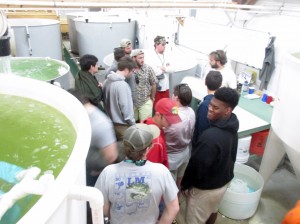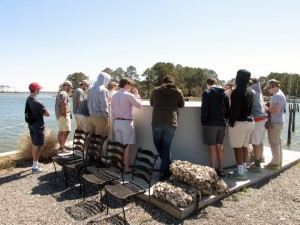The students in Prof. Werth’s Biology 343 traveled to the Middle Peninsula of Virginia to check out various sites where farmed oysters are bred and raised at a hatchery and then grown in cages in natural habitats. First they visited the Rappahannock Oyster Company on Locklies Creek in Topping, VA, where student Jamie Howard works with other ROC employees. They toured a facility and spoke with staff who farm Crassostrea virginica, the local oyster, whose populations nearly collapsed in recent decades. Now, baby oysters are placed in cages and grown in various regions where differences in salinity and other aquatic factors cause oysters of each place to develop different tastes. Each year, the Rappahannock Oyster Company grows millions of oysters, selling them locally and shipping them around the world. Students saw the boats, tanks, cages, and other equipment used by the ROC aquaculture operation, and discussed the ecology of the species that so many people like to eat.
Next, the class drove to the Oyster Seed Holding Company on Gwynn’s Island, where sterile triploid oyster embryos are produced from brood stock and where these tiny oysters are raised on different species of “clean” algae that the oysters filter from circulating water. The class discussed many aspects of oyster (and general estuarine) marine biology, particularly the fascinating aspects of algology necessary to grow the algae on which the growing oysters depend. Each year OSH sells millions of spat to companies (like ROC) that culture them until the oysters are large enough to be harvested and eaten. The class learned a lot about the life of oysters and this species’ importance to Virginia science, economics, and the restaurant and aquaculture industries.


